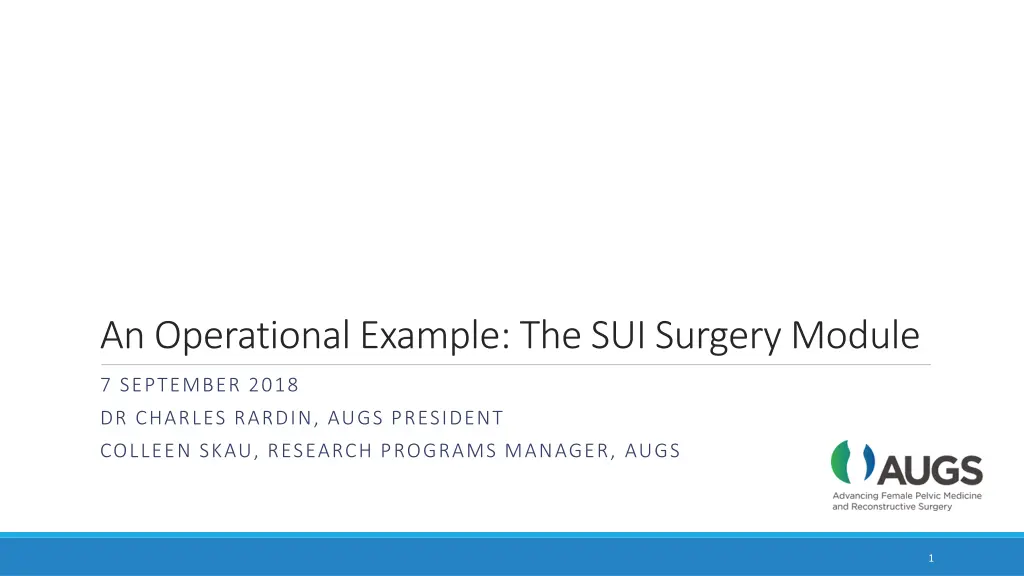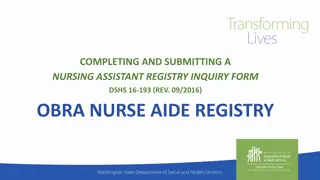
Stress Urinary Incontinence (SUI) Treatment Options and Importance of Registry
Learn about stress urinary incontinence (SUI), its causes, treatment options including non-surgical and surgical methods, and the significance of an SUI registry for evidence-based care. Understand the difference between SUI and urge urinary incontinence, and explore how failures of continence mechanisms can impact treatment outcomes.
Download Presentation

Please find below an Image/Link to download the presentation.
The content on the website is provided AS IS for your information and personal use only. It may not be sold, licensed, or shared on other websites without obtaining consent from the author. If you encounter any issues during the download, it is possible that the publisher has removed the file from their server.
You are allowed to download the files provided on this website for personal or commercial use, subject to the condition that they are used lawfully. All files are the property of their respective owners.
The content on the website is provided AS IS for your information and personal use only. It may not be sold, licensed, or shared on other websites without obtaining consent from the author.
E N D
Presentation Transcript
An Operational Example: The SUI Surgery Module 7 SEPTEMBER 2018 DR CHARLES RARDIN, AUGS PRESIDENT COLLEEN SKAU, RESEARCH PROGRAMS MANAGER, AUGS 1
What is Stress Urinary Incontinence (SUI)? Leakage of urine that occurs with physical activity: exercise, coughing, sneezing or laughing These activities increase pressure in the abdomen; for women with loss of support to the urethra, the pressure increase can cause leakage Stress urinary incontinence is different than overactive bladder, also called urgency urinary incontinence UUI is leakage caused by unnecessary contractions of the bladder itself rather than an increase in overall abdominal pressure UUI and SUI can occur at the same time: referred to as mixed urinary incontinence 2
How is SUI treated? Non-surgical options (conservative therapy): Physical therapy to strengthen the muscles of the pelvic floor (Kegels); biofeedback; external nerve stimulation Pessary is a ring-like device that can be inserted and removed; by applying compression to the urethra, it can prevent leakage Surgical options: Periurethral bulking agents: narrow the urethra by injecting substances (including carbon beads, PDMS or autologous fat) into the surrounding tissue to reduce leakage Burch or Marshall Marchetti Krantz Colpsuspension: non-device surgery that lifts the vaginal wall using stitches to support the bladder neck and urethra Mid-urethral mesh slings: surgical device that involves a thin strip of mesh placed under the urethra to support it 3
Why do we need an SUI Registry? A broad evidence base including high quality scientific papers in medical journals in the US and the world supports the use of the MUS as a treatment for SUI. There are greater than 2,000 publications in the scientific literature describing the MUS in the treatment of SUI. These studies include the highest level of scientific evidence in the peer reviewed scientific literature. Among historical SUI procedures, the MUS has been studied as long in follow-up after implantation as any other procedure and has demonstrated superior safety and efficacy. No other surgical treatment for SUI before or since has been subject to such extensive investigation. 5
What was missing? o Real-world data outside the Ivory Towers and funded investigators o Patient-Reported outcomes o Data that can be looked at in real time for performance assessment and quality improvement o In other words a Registry .
AUGS other Registry Projects o Pelvic Floor Disorders Registry oResearch-oriented registry for treatments of prolapse oInnovative use of shared comparator groups oHundreds of data fields; significant financial support for data entry and management o AQUIRE Registry oQuality registry oPerformance measures oReporting Requirements oSome Benchmarking oFast data entry, very limited fields
What we were looking for Multiple needs can be served at the same time o Registry that is condition-specific, not geared to a single device or product o Device/implant information (UDI), ideally without requiring manual entry of UDI o Benchmarking information about Quality and Outcomes o Patient reporting feature to capture what we (may have) been missing o Nimble, usable, streamlined: minimum data set, possible to do EHR integration? o Quality, not Research: data can be used to generate real quality improvement products
A partnership with MDEpiNet: WHT CRN Original plan: make SUI part of the PFDR, AUGS research registry Evaluation showed this wasn t the right home for a nimble quality registry After talks with the FDA and MDEpiNet, decided to focus first on SUI, then expand to prolapse Summer of 2017: join forces to bring AUGS SUI project on as part of the WHT CRN An outline of the data elements and design of the registry already existed MDEpiNet convened a pelvic organ prolapse working group to ID data elements around POP for a future module Delphi process is basically complete; now to make it operational! 9
The Final Data Element Set: AUGS/SUFU Workgroup of AUGS/SUFU experts started with the outline of data elements and came to consensus on a minimum data set Iterative process of identifying potential data points, much like a Delphi system Triage process where each member identified candidate data points as must have , nice to have , or don t need Data elements considered more research than quality were excluded Does the patient have diabetes? Has the patient taken medicine for overactive bladder in the past? Three data elements were added to the final set as part of AUGS development of an Advanced Payment Model for the QPP Demographic information uses US Census Bureau options 10
Making it Operational: AQUIRE and FIGmd AUGS Quality Improvement Registry, AQUIRE, already built with the registry vendor FIGmd FIGmd supports registries from 27 medical specialty societies including NBIR (plastic surgery), IRIS (ophthalmology) and cardiac registries Many registries with FIGmd, including AQUIRE, are CMS-approved QCDRs FIGmd is a platform: they build the specs specialty societies provide They do not function as a data coordinating center, they do not track quality or devices, they do not provide statistical support services or promote harmonization between registries Societies supply the expertise and content, FIGmd supplies the technology 11
Making it Operational: Building the Module Rather than build a new registry, add as a module into AQUIRE 12
Making it Operational: Building the Module In addition to the pre- and post-operative data elements, the SUI Module has a couple critical features to address the unmet need Patient-reported outcomes UDI and device tracking with AccessGUDID 13
Making it Operational: Patient-Reported Outcomes Patients receive an email 5 weeks after surgery asking them to complete just 6 questions Providers cannot modify answers 14
Making it Operational: UDI/Device Tracking Providers enter the UDI of any device they use 15
Making it Operational: UDI/Device Tracking Providers enter the UDI of any device they use 16
Making it Operational: UDI/Device Tracking Device information is pulled directly from accessgudid.nlm.nih.gov 17
The Future of the SUI Module Technical updates: mobile app to scan UDI instead of manual entry; EHR integration SUI Advanced Payment Model will be integrated with the Module AUGS Quality and Registry Committees will use data in the SUI Module to design quality improvement toolkits for providers Device tracking for efficacy and safety What else? 18
Thank you! Special thanks to the SUI Module Test Team: -Dr Michael Flynn -Dr Rebecca Batalden -Dr Julie Drolet Questions?
How were categories of data elements selected? Broad categories are: demographic/medical history, procedure information, quality/process measures, perioperative outcomes reported by provider and efficacy/QoL outcomes reported by patient; is there info on how those were chosen? Text 20
What are priorities in an SUI Surgery Registry? Minimum data set versus as much data as possible? EHR integration versus rapid onboarding? As many providers joining as possible versus a set of committed pioneer sites? Provider versus patients reported outcomes? Text 21


















